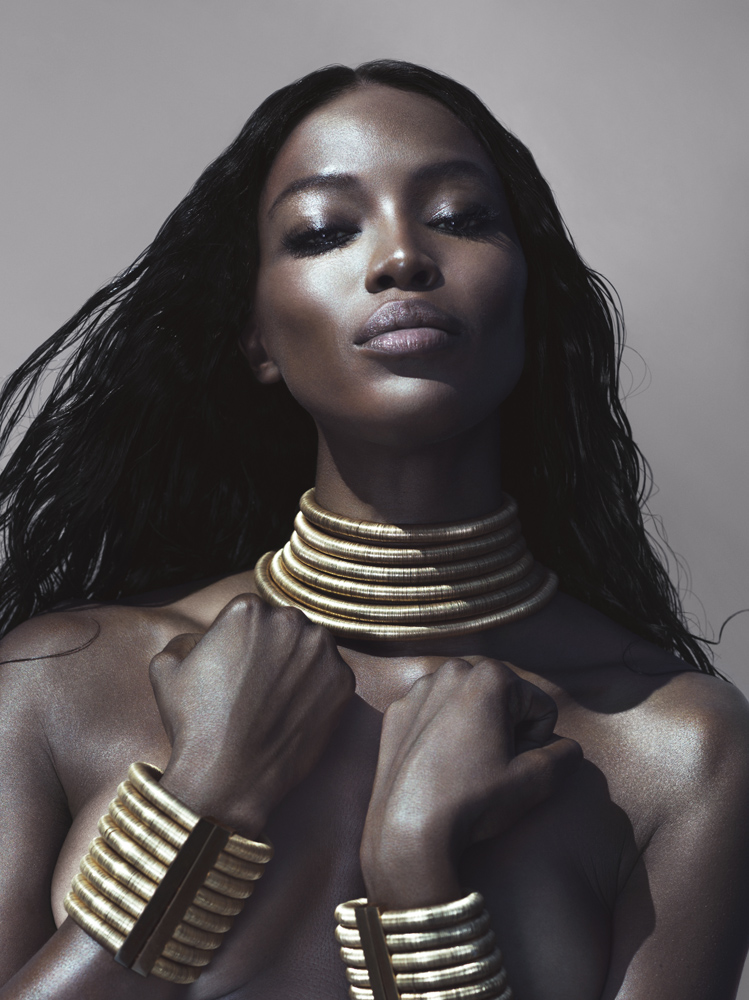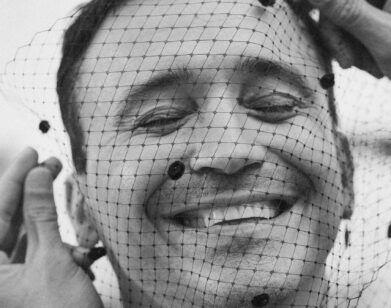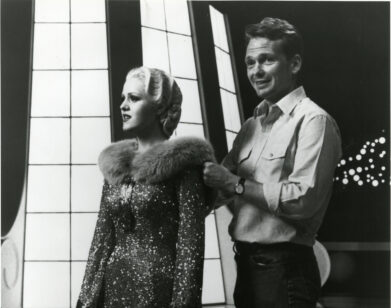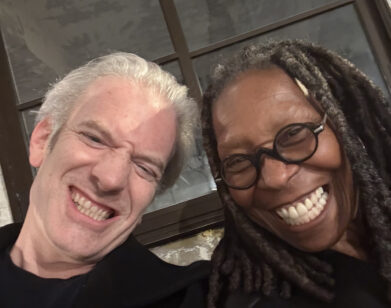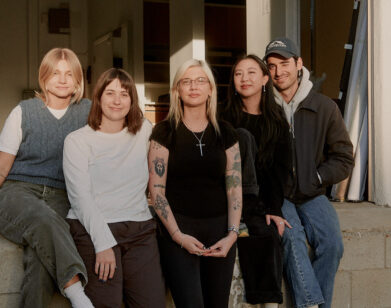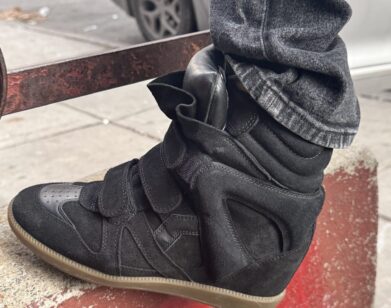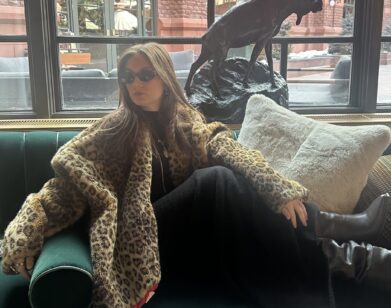Naomi Campbell by Mert & Marcus
WE DIDN’T CARE ABOUT TECHNIQUES or SHARPNESS—WE just WANTED TO MAKE SOMETHING THAT PEOPLE WOULD REACT TO. MERT ALAS & MARCUS PIGGOTT
Creative and former romantic partners Mert Alas and Marcus Piggott met in Hastings, England, in the mid-’90s and began working and living together almost instantly. Alas grew up in Turkey, studying classical music; Piggott is Welsh. While shooting campaigns for Calvin Klein or Louis Vuitton, or editorials for Pop, Arena Homme Plus, or Love, often at their seaside home in Ibiza, Alas and Piggott like to trade the camera back and forth—a sort of bonded binary entity—like Jaeger pilots in the drift. Here, they trade ideas and opinions with their friend, Givenchy creative director Riccardo Tisci, on the heels of a grand bacchanal on the island in the Mediterranean to celebrate Tisci’s 40th birthday.
RICCARDO TISCI: How did you two meet for the first time?
MERT ALAS: It was a warm summer evening. I was at a party, dancing around, and Marcus walked up to me and asked if I would like a drink. I looked at this very tanned, young, handsome guy and said, “Sure!” So we found a corner and talked all night.
MARCUS PIGGOTT: I found Mert’s number and asked him out for a date. After that, we pretty much moved in together. It was a big attraction definitely.
ALAS: Like magnets.
PIGGOTT: He was so charming, and I remember the orange boiler suit he was wearing—God, that was bright.
TISCI: How did you decide to start to working together?
ALAS: I was just out of the college of classical music in Turkey. I was always interested in fashion images and always dressed top to toe in crazy outfits. I loved clothes, loved partying. I loved everything that was visually charged and raised eyebrows. Marcus used to be a photo assistant and was an art student. He had a lot of knowledge of photography. I guess we started talking first, about photography and art, about films—we liked the same artists, the same movies. We both had a similar dark side and similar romance and madness to our ideas. He had an old camera, and we got a few lights and made one side of our apartment into a sort of makeshift studio. I got a set of 10 sort of “How to Make a Good Photo” encyclopedias, and we started playing. At first we did a lot of nudes, shooting a lot of our friends. Whatever was in those books, we tried.
TISCI: Why photography?
PIGGOTT: I was always very interested in photography. My father took a lot of pictures while I was growing up. There was always a camera, and as my father was an antiques dealer, a lot of art around us.
ALAS: I was a very visual person, even as a kid. I would set up cabaret scenes in school. I was into changing people’s looks and amused by performance, by being different—any attention I could get. Photography was a perfect recipe, I guess. I could project my desires and imagination onto paper.
TISCI: Who was the first magazine you shot for?
ALAS: Dazed & Confused. It was a quarter-page portrait of this super-talented musician Leila, who at the time was working with Björk. She arrived at our home and we started taking pictures of her, but the pictures were boring. We didn’t find normal photos that intriguing, so we tortured ourselves immensely.
TISCI: You were looking for something that had depth and intensity.
ALAS: Just beautiful was not sufficient. We didn’t care about techniques or sharpness—we just wanted to make something that people would react to. So at the end of the day, we pulled the glass out of our oven and shot her through this glass with some water drops on it. The result was dark and weird, so we published it, and straight away we were commissioned to do a series for Visionaire using the same technique.
TISCI: You are the kings of color in my opinion. Even when your colors are bright and saturated, they seem to represent darkness and are totally different from the colors of other photographers. It doesn’t seem like it comes from fashion photography.
ALAS: The mind wants to see color in a certain way. I may see a red in a photo, and my mind says, “That’s not the right red!” So you search for that right red, and that’s when something becomes yours—your red. I guess we’re all selfish, cocky artists who want to do what we believe and what we believe only. [all laugh] We just do our thing. If you’re lucky, “your thing” becomes popular and people respond to it. In our case, people seem to like it.
PIGGOTT: There is instinct involved, searching and experimenting until you are satisfied. Storytelling, surrealism, and darkness—my favorite pictures always have an element of all three.
TISCI: People talk about how fun your shoots are, which I can also say from my experience working with you. Do you think this is a strength?
ALAS: It became a strength. We are quite fun people to begin with—we like to socialize, to laugh a lot and have a good life. So we had to make it fun, because our work is our life and visa versa. Even now we are sitting at a seaside in our swimming trunks on a beautiful summer day, and still we’re working! [laughs]
TISCI: Tell me about a crazy experience on one of your shoots.
ALAS: Actually, there is a funny memory. It was our first assignment for Vogue U.K. …
PIGGOTT: And maybe the last, as they haven’t booked us for a while. [laughs]
ALAS: We went to Kenya with Kate Moss, to this place called the Paradise Island.
PIGGOTT: Which turned into a misery island.
ALAS: On the plane, this marine biologist told me we were going to get a red tide, a toxic flood that was killing all the sea life. I told the crew, who, of course, thought I was exaggerating. The next morning we woke up to the red tide and the entire beach was covered with dead fish. The whole story was supposed to be shot in the water, which we couldn’t even touch, as it was also toxic to humans. We were trying to think of ways to shoot that didn’t involve Kate getting into the water—we even built a raft. Time was running out but we were somehow hysterical, laughing the whole time.
PIGGOTT: I remember shooting with Grace [Coddington] and Lara [Stone] near a beach, and as the picture developed, we decided we wanted a baby in the shot. So Grace went down the road and borrowed a baby from a family nearby, which was so funny.
TISCI: How did you meet Kate?
PIGGOTT: I met her through Stella [McCartney] at [Central] Saint Martins.
ALAS: I met Kate at [photographer] Mark Lebon’s party. I walked up to her and said, “Hi. You are going to model for me someday.” She said, “Yeah, right,” and walked away. [all laugh]
TISCI: Describe perfection in photos in three words.
ALAS: Substance.
PIGGOTT: Beauty.
ALAS: Style.
TISCI: I’m sure you have some disagreements. How do you resolve things while you are shooting?
PIGGOTT: For the amount of the time we spend together, we really don’t fight that much.
ALAS: Totally. It’s not fighting, but there are lots of disagreements. Which I think is very healthy. If I had a partner who agreed with every one of my opinions and choices, it would be boring and unstimulating. It would drain me. I love a challenge, a critic to ignite my inspiration. I like going through some suffering to make something beautiful.
TISCI: How do you think your style has evolved?
ALAS: When you are a punk, you are a punk, it doesn’t matter what you achieve or how successful or recognized you become. Look at Björk or Vivienne Westwood or Marina [Abramovic]—it doesn’t matter where you get to in life, the core element of your character is stuck with you till the end. What I do miss, though, is the purity and the bravery that comes with inexperience. You kind of throw yourself into a battleground with nothing to lose but your poor head.
PIGGOTT: We had no fear in the ’90s, when we started. We were so much more free, raw—not just “we” as in Mert and Marcus, but “we” as in all of the ’90s generation.
ALAS: I agree. The ’90s was a special moment for all of us. It was the birth of the new language in art and fashion. It was about breaking rules, not sales records. And we are at a plateau of creativity in society at the moment. It’s all very marketing-conscious now-no more mistakes, no more accidents. We really need to fight this. We can’t have art that’s been programmed and sold. We have to be inspired to inspire, and rules are not inspiring.
TISCI: You make great images-you practically make dreams. Some say retouching is an art form. What do you think? How do you describe your process?
PIGGOTT: Like the darkroom where we used to play with chemicals, our tools have changed, but intentions are still the same.
ALAS: Man Ray used to retouch, so did Avedon. Some people confuse image-making with image-enhancing. We all know that you can slim out a waist, brighten up eyes, and take wrinkles off, but our work goes far beyond this. It’s about making something, not faking something.
TISCI: So what do you guys think about photographers adopting your style?
PIGGOTT: It’s always a compliment.
ALAS: I like the fact that we inspire other artists, the way we were inspired once ourselves. But believe me, sometimes I look at a picture and say, “Wow, when did we shoot that?” And my assistants answer, “We didn’t!” Which is really fucking annoying. [laughs]
TISCI: Tell me about the icons of yesteryear that you would have loved to shoot.
ALAS: Visually, Marilyn Monroe.
PIGGOTT: Debbie Harry.
TISCI: How about any women of our time that you haven’t worked with but would love to work with?
ALAS: Honey, we’ve worked with them all!
PIGGOTT: How about Bette Midler? She is so talented. I love her.
TISCI: You are very famous for transforming people. Is there someone you would love to make into an M&M woman?
ALAS: Anna Wintour.
TISCI: Which artists do you admire the most?
PIGGOTT: As a child, I used to find it very intense looking at Bosch, almost like an out-of-body experience. There was so much to explore in his work, all the details and scenarios and sexuality in one painting. And the first time I saw a French Vogue with pictures by Helmut Newton was super intense.
ALAS: I associate myself with the late 1920s and early ’30s, with the beginning of surrealism, Dada, Bellmer, Dalí, Delvaux. I wish I were a part of something like that, or the Beat generation.
TISCI: Where would you love to shoot?
ALAS: The moon. Or heaven.
TISCI: What does the word sex mean to you?
ALAS: Confusion, spontaneity. For me, flesh and nudity does not represent sex in any way. It is the unknown, something behind the wall, that is sexual.
PIGGOTT: Fantasies. Power and imagination.
TISCI: You shoot swans or a car in flames, but in all the craziness and surreal ideas, you seem to always have a reality that I connect to. I think that’s why people get really attached to your work—it’s a dream but they feel as though they can be part of this dream.
ALAS: We think a lot while we shoot—before, during, and after—about the world of the subject. Would this chair be right for her? Would she sit with that robe? So, we create this dream as we go along. And spontaneity brings some reality and life to the image … Oh, Ricky, I don’t really know!
TISCI: What don’t you like about your work?
ALAS: It would be great to have more time for ourselves. But you choose your path, so you could have more time if you choose to.
PIGGOTT: Also you start to compete with yourself and want to make every picture better than the one before, which adds to the stress. It would be great to have more time to develop some film ideas—which we are doing.
ALAS: This year we have been good, though. We took fewer assignments so we could have some weekends to do other things, like work on our first book.
TISCI: Book? That was my next question. How have you guys not yet had any big exhibitions or made any books?
ALAS: I didn’t think we were ready. We really are the biggest critics of our own work, so it’s hard to impress ourselves. And we wanted time to create this repertoire and not push it. Now the time has come. Let’s see.
TISCI: What is the last thing you think before you close your eyes at night?
ALAS: “Hope I wake up tomorrow!”
RICCARDO TISCI IS THE CREATIVE DIRECTOR OF GIVENCHY.
For more from the Photographers’ Portfolio, click here.

